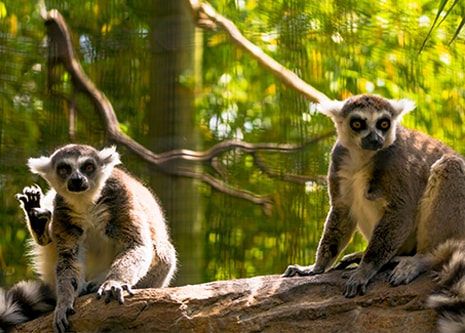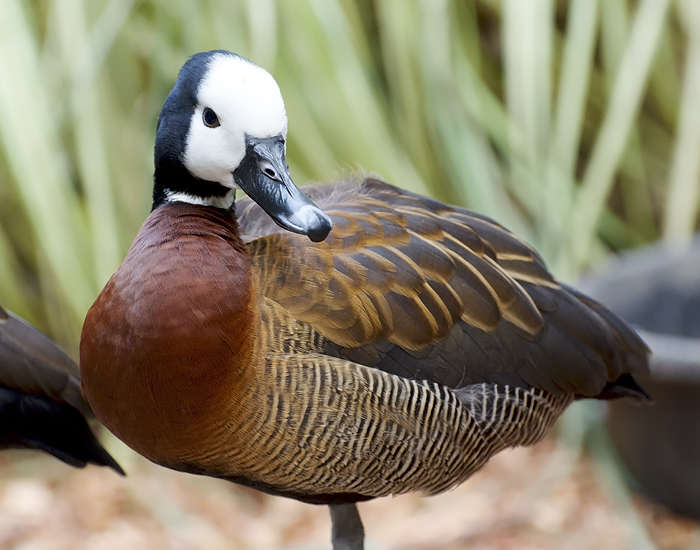
- VisitSupport Happy HollowDONATE TODAYExploreSupport Happy HollowDONATE TODAYLearnSupport Happy HollowDONATE TODAYSupport
-
Today's Hours: 10:00 am to 4:00 pm
Zoo in the HollowWhite faced whistling duck
Scientific name: Dendrocygna viduata
Family: Anatidae
Order: Anseriformes
Class: Aves
Range: Central and South America, Sub-Saharan Africa, and Madagascar
Habitat: Wetland
Lifespan: Unknown in the wild; Up to 12 years in captivityWhat do they look like?
White-faced whistling ducks have relatively long legs, necks, and bills. Like their name implies, white-faced whistling ducks have a white face that strongly contrasts with the back
of their heads, which are black. Their chest is chestnut-colored, and their wings and
posterior are brown. Their sides are finely barred with black and white and their tail and
belly are black. This species is monomorphic (males and females look the same).How do they behave?
White-faced whistling ducks belong to a group of ducks known as “whistling ducks”, named
for their distinct calls. They look and behave less like typical ducks and more like swans or
geese. These ducks spend a great deal of time allopreening (using their bills to clean one
another). This behavior is not seen in most ducks, but it is seen in other highly social birds,
such as parrots. Because of their highly social nature, these birds can be found in flocks of up
to several thousands of individuals. White-faced whistling ducks spend most of their time in
fresh water.What’s on the menu?
These ducks are mostly herbivorous (plant eating). They eat a variety of seeds and fruits, and
aquatic plants. A small part of their diet consists of aquatic invertebrates such as insects,
crustaceans and mollusks. These birds mainly forage at night for food. At the Zoo they eat
specialized bird food, green vegetables, and mealworms.How are they born?
Unlike other duck species, all whistling ducks mate for life, and the males and females form
close bonds. Both males and females take care of the young. Typically, nests are built on dry
ground or in reeds, but may be built in tree crevices. Because of this, whistling ducks are also
known as “tree ducks.” Females lay between 4 to 13 eggs that gestate between 26 to 30
days. Ducklings take about 8 weeks to fledge (fly). After their breeding season they have a
short molting period. During their molt, they are unable to fly and are more vulnerable to
predation.Conservation Connection!
These ducks are currently listed as a species of Least Concern according to the International
Union for Conservation of Nature (IUCN) due to their large habitat range across Central and
South America, as well as throughout Sub-Saharan Africa. Despite this listing, their
populations are still susceptible to overhunting and several diseases such as avian botulism
and avian influenza, which requires them to be continuously monitored by conservation
groups such as Birdlife International who then use their data to update the IUCN. If you
would like to help your local waterfowl species, you can keep your fertilizer (chemicals
added to the ground to aide plant growth) and pesticide (chemicals used to kill plants,
insects or rodents) usage to a minimum during the wet season to prevent chemical runoff
into their wetland habitats. Maintaining healthy local ecosystems is not only a great way to
ensure that the animals around you are healthy, but also to protect your own water sources!
Zoo on the Hill
Located across from the Keep-Around Carousel is the Zoo on the Hill. Learn about wildlife up close during daily meet-and-greets, leap like a lemur on the playground, brush and feed the goats,, or take a peek inside Doc’s Critter Care building and the Ranch House. Double-H Ranch features a combination of animal exhibits, including giant anteaters and red ruffed lemurs, as well chickens and domesticated animals that are docile enough to touch.
See Animals
Education Ambassadors
From camps and classes to scout badges and sleepovers, Happy Hollow education programs have something for everyone! The zoo education program offers a broad range of hands-on, engaging programs and public presentations featuring education ambassador animals. These encounters are designed to connect you to wildlife and the conservation of their habitats around the world.
See AnimalsVisit Us Today
Plan an unforgettable experience at San Jose’s family-friendly park and zoo.
Learn More
